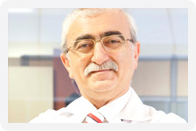Real-time patency control with thermal coronary angiography in 1401 coronary artery bypass grafting patients
(european journal of cardio-thoracic surgery - 2003, 2003;24: 961-6)
Abstract: Intraoperative coronary angiography has always been favoured by cardiac surgeons. Thermal coronary angiography (TCA) is a useful method for intraoperative control of graft patency. It detects heat differences between tissues, provides easy-to-interpret angiographic images and even measures the flow of the grafts quantitatively. Methods: Between January 2000 and January 2002. TCA has been used in scheduled coronary bypass operations. Upon completion of each distal anastomosis, the perfusion of the distal arterial tree from the graft was evaluated with a thermal camera. Results: TCA was aqqlied to 1401 patients, meam age 60.97±9.61 years, who underwent simple coronary artery bypass grafting (CABG) procedures. A total of 4105 thermal images were obtained including 2161 venous, 1355 single internal thoracic artery (ITA), 56 bilateral ITA and 477 radial artery grafts. Image quality was not sufficient in 34 grafts (1.57%) due to either deep intramyocardial vessels or excessive epicardial fat tissue. Technical failures in there ITA anastomoses were detected and revised before the cross-clamp was removed. Flow-restricting lesions distal to the anastomosis on the left anterior descending artery (LAD) in nine patients were managed with a secondary distal bypass graft flow and the distal visualization was not satisfactory. Although the anastomoses were performed on a good lumen. Angiographically undetected diagonal arteries were revascularized in 11 patients with totally occluded LAD vessels. Conclusion: Thermal imaging provides decisive coronary angiographies, and detects the perfusion area and flow of the implanted graft. It allows real-time detection of technical failures, reveals unexpected occluding plaques or any kind of flow-restricting lesions , and gives the chance of refinement of the anastomosis during the arrest period. We believe that the thermal imaging technique is a safe, noninvasive and feasible method to document the quality of the myocardial revascularization intraoperatively




